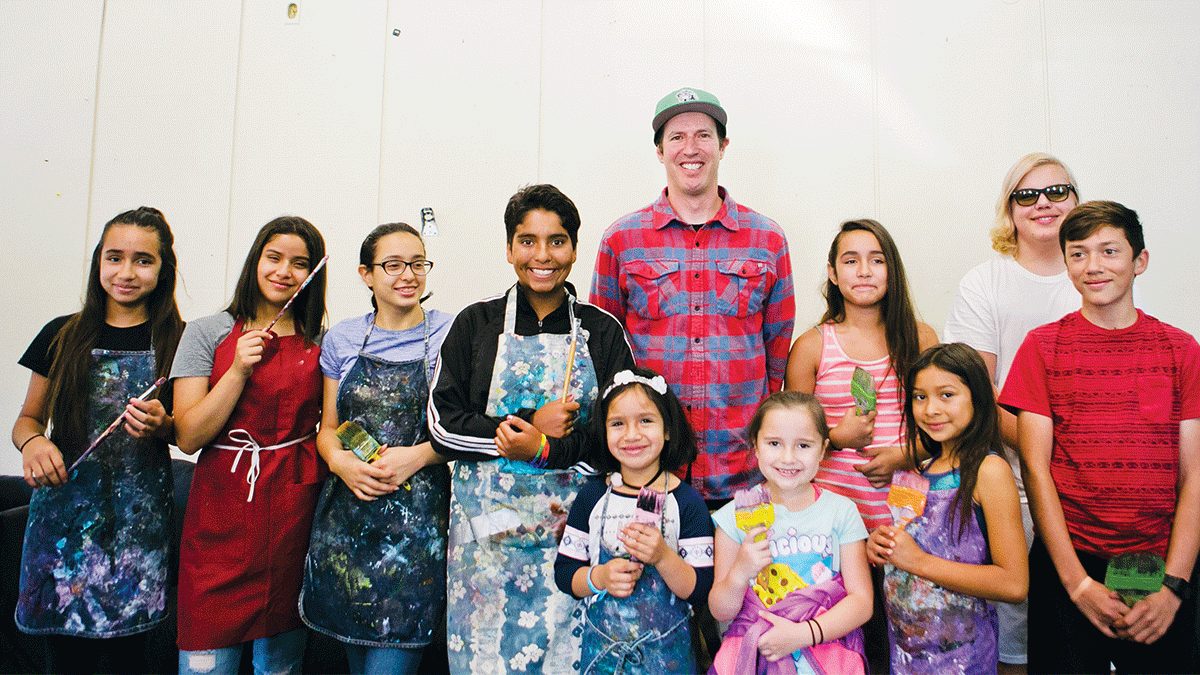Scotty Greathouse’s summer vacation plans involve lots of painting.
The 43-year-old Felton resident and father of two will work with teenagers to design and install two murals on the roughly 15-by-30-foot walls outside two Boys and Girls Club locations. The teens will brainstorm the subject matter when the summer program begins in July, he says, under the theme “What do you come to the Boys and Girls Club for?” They’ve already had one meeting with the kids to get ideas flowing for the spots in downtown Santa Cruz and on 17th Avenue.
“Some of the words so far are ‘fun,’ ‘inspiration,’ ‘friendship,’ ‘art’—things like that,” says Greathouse, a contractor specializing in art and graphics. “It’s going to show the kids how to take an image from an 8.5-by-11 piece of paper and enlarge it to that scale.”
His idea is to have each kid pick a color and paint different cut shapes of fiberboard and place them on the wall. The negative space, or gaps in between the pieces, will spell out the words, giving the piece a mosaic feel.
“The goal is to really open their eyes to the possibility of career choices in the art field,” he explains of his aim to inspire the young people involved. “The thing that I never got in school was the actual hands-on ability to make a design and make it that big, have the process explained and have someone there who’s an open book.”
With support from a California Arts Council grant, Greathouse says he’ll take the teens through each phase of the process. They’ll learn about which colors work together, how white space can work within a mural, laying out the design, budgeting purchases and how to select materials. Greathouse, who once hosted an event through the Boys and Girls Club teaching kids to skate, says children make for eager learners.
“I love their energy,” says Greathouse. “The kids come in and they’re so excited about everything.”
Andrea Tolaio, development officer for the Boys and Girls Club, hopes the summer program keeps kids engaged during the year’s long, school-free stretch. She says that as youth reach their mid-teen years, retention begins to dip, due to teens taking part-time jobs and having more freedom to structure their own free time.
“We tend to lose some of our kids around age 14, 15 or so, and there are a multitude of studies that show if teens continue to attend Boys and Girls Club as they get older, they have a higher propensity to graduate from high school, go to college and really explore career opportunities,” says Tolaio.
The club is trying to combat the dropoff, says Tolaio, by instituting more real-world and college-readiness activities, expanded club hours, and support for job and college applications.
One quarter of families and 18 percent of children in 2014 relied on afterschool programs to provide safe, supportive environments to inspire learning, according to a 2014 report by Afterschool Alliance, a nonprofit based in Washington, D.C. Many families can’t afford summer programs, which come at often steep prices.
“Most of them have both parents working, and the cost of summer camps range anywhere from $300 for a half-day week all the way to thousands of dollars for overnight camps,” says Tolaio.
Summer vacation, after all, isn’t a thing for most parents, leaving some kids to fend for themselves. And when children stop learning over the break, they lose their math and reading skills—which turns the gap between rich and poor kids into a chasm. Lower-income students often don’t catch up, according to a 2014 article from the New York Times.
The local Boys and Girls Club’s “Smart Summer Program” offers a variety of academic and enrichment classes, all free for teenagers.
“[The Boys and Girls Club] is a safe place to come where kids know they’re welcome and appreciated. Their parents know that they’re going someplace safe and fun. For some of our kids, they would be at home doing nothing. The number of kids that spend time alone unsupervised is really alarming,” says Tolaio. Eleven percent of children ages six to 12 spend an average of 10 hours a week on their own in the summer months, according to an estimate from Afterschool Alliance.
By October, Greathouse also plans to begin work on a larger-scale 500-by-nine-foot mural on a wall enclosing Bayview Elementary on Mission Street.
The project, a partnership with Clean Oceans International, will be the biggest mural in the county, and use oceanic themes to educate Bayview students about pollution. Greathouse and his partners are in the early stages, still tinkering with ideas, but they may custom-make ceramic tiles for Bayview students to glaze that could then be incorporated into sea turtle shells.
To show the plastic pollution, they’re thinking about painting the Hawaiian monk seal or albatross with an X-ray-like cross-section that shows the contents of their stomach filled with plastic.
“We want to show what some of these sea creatures are consuming, and that it’s actually our problem. We’re the ones who created it, but we’re the ones who can actually turn it around,” says Greathouse, who’s fundraising to support the project. “We don’t want the wall to be all doom and gloom. It’ll be beautiful but also have that education intertwined.”
To learn more about the about the Bayview Elementary mural, go to cleanoceansinternational.org. For fundraising updates, visit Fresh Wall Project on Facebook.














